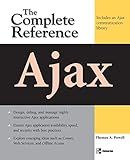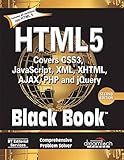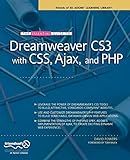Best AJAX & PHP Guides to Buy in October 2025

php html javascript ajax jquery



Learning PHP, MySQL & JavaScript: A Step-by-Step Guide to Creating Dynamic Websites



Ajax: The Complete Reference



HTML 5 Black Book, Covers CSS 3, JavaScript, XML, XHTML, AJAX, PHP and jQuery, 2ed



The Essential Guide to Dreamweaver CS3 with CSS, Ajax, and PHP (Friends of Ed Adobe Learning Library)



Framework PHP Laravel 8 & AJAX: Aprenda fazendo: Projeto completo (Portuguese Edition)



Learning PHP, MySQL & JavaScript: A Step-by-Step Guide to Creating Dynamic Websites


AJAX stands for Asynchronous JavaScript and XML. It is a technique used for sending and retrieving data from a server without refreshing the entire webpage. Combining AJAX with PHP allows you to create more dynamic and interactive web applications.
To use AJAX with PHP, you need to follow these steps:
- Create an XMLHttpRequest object: In JavaScript, create a new instance of the XMLHttpRequest object. This object is responsible for making requests to the server.
- Define a callback function: Create a JavaScript function that will be executed when the server responds to the AJAX request. This function will handle the retrieved data and update the webpage accordingly.
- Open the connection: Use the open() method of the XMLHttpRequest object to specify the type of request (e.g., GET or POST) and the URL of the server-side script (PHP file) that will handle the request.
- Set the request header: If you need to send additional data or specify the content type, use the setRequestHeader() method of the XMLHttpRequest object.
- Send the request: Use the send() method of the XMLHttpRequest object to send the request to the server.
- Handle the server response: When the server responds, the callback function defined in step 2 will be executed. Inside this function, you can retrieve and manipulate the server's response using the responseText or responseXML properties of the XMLHttpRequest object.
- Process the data on the server-side: In the PHP script that handles the AJAX request, you can perform any necessary data processing and return the result or required data. This can include querying a database, performing calculations, or any other server-side logic.
- Update the webpage: Once you have received the data from the server, you can use JavaScript to update the webpage's content dynamically. This could involve modifying HTML elements, showing/hiding sections, or altering the page layout based on the received data.
Overall, by combining AJAX and PHP, you can create interactive web applications that can fetch data from the server without reloading the entire page, leading to a smoother and more efficient user experience.
What is the purpose of using JSON with AJAX and PHP?
The purpose of using JSON (JavaScript Object Notation) with AJAX (Asynchronous JavaScript and XML) and PHP is to facilitate the exchange of data between a web browser (client-side) and a web server (server-side).
JSON is a lightweight data interchange format that is easy to read and write for humans and can be quickly parsed and generated by machines. It allows for sending and receiving structured data between different systems easily. JSON is often used as a data format in web services and APIs.
When combined with AJAX, which is a set of web development techniques that allow for asynchronous data exchange between a web browser and a server, JSON enables the retrieval and manipulation of data in the background without interfering with the display and behavior of the existing web page. This asynchronous data exchange improves the user experience by providing real-time updates and dynamic content without requiring complete page reloads.
PHP, being a server-side scripting language, is often used to process and generate JSON data in response to AJAX requests. PHP can interact with databases, perform server-side calculations, and handle various data processing tasks. By using PHP, developers can fetch data from a database, format it as JSON, and send it back to the client-side code for rendering or further processing.
In summary, the purpose of using JSON with AJAX and PHP is to enable efficient data exchange and provide a better interactive experience for the web application users by allowing real-time data updates without reloading the entire page.
What are some popular AJAX libraries for PHP?
Some popular AJAX libraries for PHP include:
- jQuery: Although it is primarily a JavaScript library, jQuery has excellent AJAX support and is widely used in PHP web development.
- Prototype: Prototype is a powerful JavaScript framework that provides rich AJAX functionalities and is commonly used in PHP applications.
- MooTools: MooTools is another popular JavaScript library with AJAX capabilities, offering a modular and extensible architecture.
- Symfony: Symfony is a PHP framework that includes a built-in AJAX component, making it easy to handle AJAX requests and responses.
- Laravel: Laravel is another PHP framework that provides seamless integration with AJAX through its built-in capabilities or by using third-party libraries like Axios or Axios-like.
- CodeIgniter: CodeIgniter is a lightweight PHP framework that offers robust support for AJAX and provides an AJAX-based form validation library.
- Yii: Yii is a high-performance PHP framework that comes with a powerful set of AJAX functionalities, including support for AJAX validation and form submission.
- Phalcon: Phalcon is a full-stack PHP framework that includes a flexible AJAX implementation, enabling developers to create dynamic and responsive web applications.
These are just a few examples, and there are many other AJAX libraries available for PHP, depending on your specific requirements and preferences.
What is AJAX and how does it work?
AJAX stands for Asynchronous JavaScript and XML. It is a web development technique used for creating interactive web applications. AJAX allows updating parts of a web page without requiring a full page refresh.
Traditionally, when a user interacts with a web page, the entire page needs to be refreshed to display the updated data. However, with AJAX, you can send requests to the server in the background and retrieve only the necessary data, without reloading the entire page.
Here's how AJAX works:
- Event Trigger: An event, such as a button click or form submission, triggers an AJAX request.
- XMLHttpRequest: JavaScript's XMLHttpRequest object is used to create an asynchronous HTTP request.
- Server Communication: The XMLHttpRequest object sends the request to the server without disrupting the user's interaction with the web page.
- Server Interaction: On the server side, the request is processed, and the requested data is retrieved or modified.
- Response Handling: The server sends back the response to the XMLHttpRequest object.
- DOM Manipulation: JavaScript code on the client-side receives the response and dynamically updates the specific part of the web page to reflect the changes without reloading the entire page.
AJAX commonly uses JSON (JavaScript Object Notation) instead of XML for data transmission due to its lighter weight and easier parsing. However, the term AJAX remains for historical reasons.
What is the difference between synchronous and asynchronous AJAX requests in PHP?
Synchronous AJAX requests in PHP wait for a response from the server before allowing the rest of the application to continue running. This means that the browser is blocked until the request is completed, which can lead to a poor user experience if the response takes a long time.
On the other hand, asynchronous AJAX requests in PHP do not block the browser and allow the application to continue running while waiting for a response from the server. This improves user experience by not freezing the interface and allows for multiple requests to be made simultaneously.
In terms of implementation, synchronous AJAX requests in PHP use the XMLHttpRequest object in a blocking manner, typically using the send method to send the request and the responseText property to retrieve the response.
Asynchronous AJAX requests in PHP also use the XMLHttpRequest object, but in a non-blocking manner. They use the onreadystatechange event handler to handle the response asynchronously, usually by using a callback function when the readyState and status properties indicate a successful response.
Overall, the choice between synchronous and asynchronous AJAX requests in PHP depends on the specific requirements of an application. Synchronous requests are simpler to implement but can negatively impact user experience, while asynchronous requests provide a better user experience but require more complex handling.
What are the common AJAX security practices in PHP?
Some common AJAX security practices in PHP include:
- Use input validation and sanitization: Validate and sanitize all user input to prevent malicious code injection. Use PHP filtering functions or regular expressions to validate and sanitize input.
- Implement CSRF protection: Implement Cross-Site Request Forgery (CSRF) protection by including CSRF tokens in AJAX requests. These tokens are generated by the server and validated on every AJAX request to prevent unauthorized actions.
- Set appropriate CORS headers: If your AJAX requests are made to a different domain, set Cross-Origin Resource Sharing (CORS) headers on the server-side to control which domains can access your resources. This prevents unauthorized access to sensitive data.
- Use prepared statements or parameterized queries: When interacting with a database, use prepared statements or parameterized queries to prevent SQL injection attacks. This ensures that user-supplied data is properly escaped before being added to database queries.
- Implement server-side authentication and authorization: Implement a secure authentication and authorization system on the server-side to restrict access to AJAX resources. Verify user credentials, ensure they have the necessary permissions, and use session management to maintain user sessions securely.
- Enable secure cookies: Set the secure and HttpOnly flags on cookies when using them for session management. The secure flag ensures that the cookie is only transmitted over secure (HTTPS) connections, and the HttpOnly flag prevents client-side scripts from accessing the cookie, mitigating the risk of cross-site scripting (XSS) attacks.
- Protect against information disclosure: Be cautious not to expose sensitive information in AJAX response messages. Limit the amount of information disclosed to clients and avoid leaking sensitive data that could be exploited by attackers.
- Implement rate limiting or throttling mechanisms: Implement rate limiting or throttling mechanisms to prevent malicious users from abusing your AJAX services. Monitor and limit the number of requests per user or IP address to mitigate potential denial-of-service (DoS) attacks.
These are some of the common practices that can help enhance the security of AJAX requests in PHP applications, but it's crucial to regularly stay updated on the latest security best practices and standards to safeguard against emerging threats.
